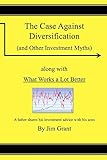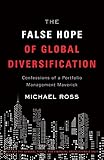Mummy bear said 'This is too diversified'.
Daddy bear said 'This is not diversified enough'.
And baby bear said 'This portfolio is diversified just enough'.
Diversification of a portfolio is a balancing act, that's why it is also called 'portfolio balance'.
Too much risk tilts the balance one way.
Too little or too much diversification tips it the same way.
An investor is looking to tip the balance in favor of maximum benefit for minimum risk.
This can be achieved if the portfolio balancing act pleases baby bear.

Diversification Of A Portfolio: Lower Risk, Same Return On Investment
by humagaia
Diversification of a portfolio of investments brings lower risk, without diluting potential return on investment. But over-diversification is as harmful as under-diversification.
Free Video Series Reveals How To Launch Recession Proof Income Streams From Scratch
Diversification aka Portfolio Balance
How To Protect Against Risk
What is the best way to protect against risk?
The objective of any investor is to lower the risk without lowering the potential return on investment.
The best way of achieving this is by diversification (aka portfolio balance).
This can be achieved, if you are investing in equities (stocks [US], shares [UK]), by buying into a range of sectors and / or geographically.
Rule Number one: Do not put all your egg's in one basket.
Diversifying without striking the right balance is unwise.
Over-diversification can dilute the efficacy of the technique.
Over-diversification happens when an investor buys too wide a range of securities, for the money available. Each investment becomes too dilute, with the costs associated with purchase and sale taking too large a proportion of potential returns.
The investment becomes so diluted (in investment value) that it has negligible impact on the overall investment portfolio. A side effect of this is that the dealing costs increase, as a percentage of the investment value. Both of these effects are ones that an investor needs to avoid.
Under-diversification occurs when too high a percentage of the total investment is placed with one or two securities.
Just like the company that relies on one or two customers for it's income, and then goes bust when one of the customers goes elsewhere, relying on too few securities can bring fateful consequences.
Investment Diversification
 |  |  |
| Beyond Diversification: What Every In... | The Case Against Diversification: and... | Energy Trading and Risk Management: A... Only $79.87 |
 |  |  |
| The Art of Diversification: How to Bu... Only $7.99 | The False Hope of Global Diversificat... | The Allocator's Edge: A Modern Guide ... Only $20.11 |
Diversify To Minimise The Risk Return Ratio For Your Portfolio
Making the correct investment decisions
You must ask yourself some serious questions about risk.
- What level of risk is involved with a particular investment?
From your analysis, is it low, medium, or high risk? - What potential size of return can be expected?
From your analysis, will it afford a high, medium, or low potential return on investment? - Can you justify the level of risk for the potential return?
Which of the following combinations does your potential investment fall into?
- If it is low risk, high return, then the risk return ratio is low - an investment 'Yes'.
- If it is low risk, medium return, then the risk return ratio is low to medium - an investment 'Yes'.
- If it is low risk, low return, then the risk ratio is medium - an investment 'maybe'.
- If it is medium risk, high return, then ratio is medium - 'maybe'.
- Medium risk, medium return = medium risk ratio = 'maybe'.
- Medium risk, low return = high risk ratio = 'No'.
- High risk, high return = medium risk ratio = 'maybe'.
- High risk, medium return = high risk ratio = 'No'.
- High risk, low return = high risk ratio = 'No'.
The answers to the questions above will give you the answer to whether it is prudent to make the investment or not. If you are risk averse, then you may wish to adjust my answers to a more negative stance. If you are comfortable with risk, then a more positive stance may be right for you.
- Those that have a 'Yes' should be invested in according to which give the best return on investment.
- Those that have a 'maybe' should be further analysed to see if the returns outweigh the potential losses and risks.
- Those that are a 'No', drop from any further consideration, no matter what your heart or head is telling you.
You must be logical in your decisions with regard to investment.
Otherwise you are more likely to make the wrong investment decisions more often.
Next Investment Article
Conclusion On Diversification
Diversify the investments within a portfolio, but do not over-diversify.
A balanced diversification of a portfolio gives lower risk without diluting the potential return on investment.
You might also like
July 15th 2013 The Hostess Twinkie Makes The Sweetest Comeback...Hostess will be back and the stock and on your local store shelves this July ...
Best Money Saving TipsEffective money saving tips which are common sense but useful.





 Gold Barson 10/19/2017
Gold Barson 10/19/2017
 Creating My Own Websiteon 02/04/2021
Creating My Own Websiteon 02/04/2021
 Weights and Measures of Gold Barson 10/20/2017
Weights and Measures of Gold Barson 10/20/2017
 Types of Goldon 10/20/2017
Types of Goldon 10/20/2017


Comments